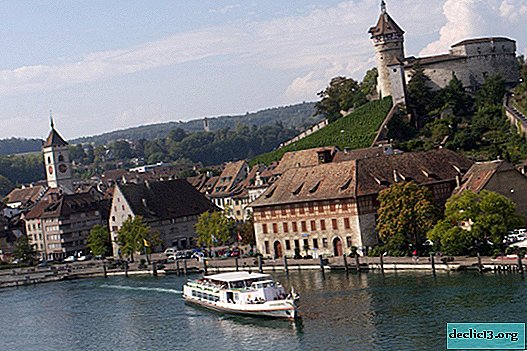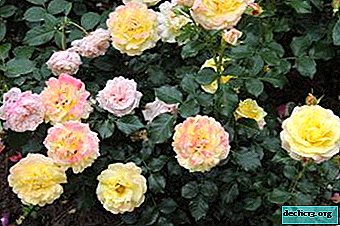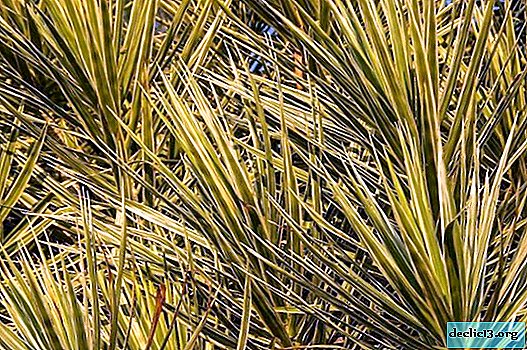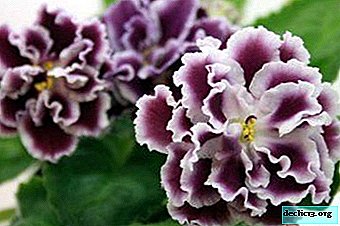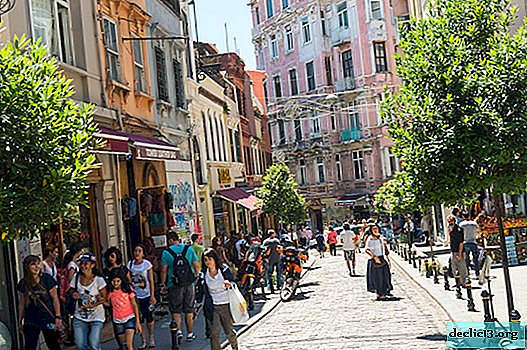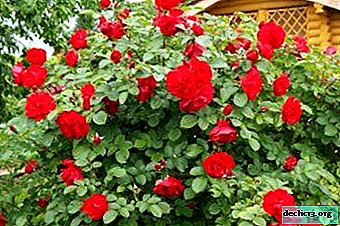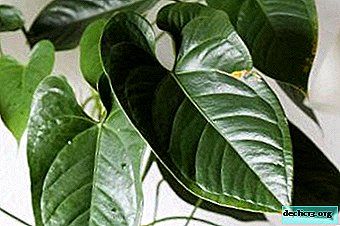Garden beauty for all time - rose Pierre de Ronsard! How to propagate a flower and take care of it?
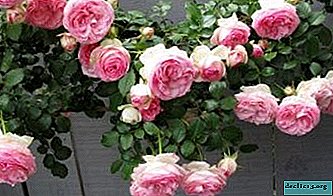
There are varieties of roses that are popular for a certain time. This is a kind of fashion statement. And other species are loved and appreciated for more than a dozen years.
They are recognized as classics of garden flowers. It is to the flowers that stand above momentary love that the rose Pierre de Ronsard belongs.
In the article, we will consider how to properly care for this sort of rose.
Detailed description
Rose of the variety Pierre de Ronsard (Pierre de Ronsard) - climbing, rose of the world. Maybe stamped. I would like to note that the branches are quite rigid, so it looks more like a bush. It grows to 3.5 meters in height and up to 2 meters in width. Shoots are characterized by slow growth, in this regard, the decorative bush can be seen after three years of age.
The sheet plate is large, stiff, richly green. There are few thorns. The flowers are large, 7-10 cm in diameter, sometimes up to 12 cm in size. The shape is cup-shaped or rosette-shaped. Petals are long, about 55-65 pieces on one inflorescence. Flowers do not bloom quickly, appear singly.
Color - a combination of several shades: from ivory, beige to pale pink. The middle is marked with a more intense color. The bud color of the petals is light green. The aroma is subtle, barely perceptible.
Photo
Further on the photo you can see what the rose Pierre de Ronsard looks like.




History of occurrence
This rose deservedly takes its place of honor in the encyclopedia of roses. This variety can be called royal, which brought the French breeding company "Mielland". In 1985, in Paris, this variety was named after the famous medieval poet Pierre de Ronsard, who in the same year celebrated the 400th anniversary of his death. In France, the name of the poet is known to everyone, but not very much in the rest of the world. Therefore, the representative of the company "Mielland" Klaus Strobel insisted on the second name "Eden Rose" or "Eden Climber".
Interesting. Since 2000, the variety Pierre de Ronsard has repeatedly won various awards in the United States. And in 2006, the rose received the title of “World Loved Rose” from the World Federation of Rose Growing Communities.What is the difference from the rest of the species?
Not only the external variety data deserve praise, but other characteristics are no less obvious:
- excellent immunity, resistance to fungal diseases;
- high tolerance to all pests;
- drought tolerance;
- very long and plentiful flowering.
The variety is re-flowering or remontant.
Bloom
The flowering period for roses begins in mid-June and lasts until the first frost. This species was bred for a warm Mediterranean climate., therefore, continuous flowering, inflorescences bloom one after another, while not losing aesthetics under the influence of wind and rainfall. However, in the northern regions of our country, as a rule, there is not enough heat, and some of the buds remain unopened.
Care before and after flowering
 With the advent of spring, they are fed with nitrogen-based fertilizers, and with the advent of the first buds, nitrogen cannot be used. Instead, it is possible to use liquid mullein along with potassium-phosphorus fertilizers.
With the advent of spring, they are fed with nitrogen-based fertilizers, and with the advent of the first buds, nitrogen cannot be used. Instead, it is possible to use liquid mullein along with potassium-phosphorus fertilizers.
Pierre de Ronsard, like other varieties, requires: regular loosening of the soil, cutting of dry lashes, removal of weeds, watering. After flowering, the climbing rose must be correctly cut. Cut off faded buds, grassy shoots, pinch growing shoots over 3-4 buds to stimulate shoots.
What to do if it does not blossom?
Usually, lack of flowering foreshadowed the wrong care measuresor the flower is poorly moved away from winter. To restore beauty, you should normalize the care process, observing the rules related to this type of climbing roses, and also competently complete the preparations for the winter period.
Landscape design
Pierre de Ronsard grows well up, so it is often used to decorate various buildings, architectural structures. We will use a flower to create elements of vertical gardening in parks, gardens, and outdoor areas of cafes. If you want to create an atmosphere of medieval France on the site, then the variety Pierre de Ronsard is definitely suitable.
Step-by-step instructions for growing and caring
For roses of this variety, the following agricultural measures are needed.
Seat selection
Basically, all roses of climbing varieties are recommended to be planted in places well-lit by the sunprotected from drafts and cold winds. Due to heat and light, the plant will receive maximum growth. The first three years, the bush may be of small size, but in the future the growth will be obvious, therefore, support should be provided in the form of a wall, fence, decorative design.
What should be the soil?
The most successful soil for roses Pierre de Ronsard should be fertile, loose, breathable. Black soil is perfect for planting, but it will also grow well in loam or sandy loam. If possible, the soil shall be diluted with peat, organic fertilizers, turf soil, sand, ash. Do not neglect drainage. It is usually made of chipped brick or gravel.
Important. Land for roses should have a pH of 5.5-6.5.Landing
 It is considered that the best time for planting a climbing rose is spring. When the street is already stable heat, about the second half of May.
It is considered that the best time for planting a climbing rose is spring. When the street is already stable heat, about the second half of May.
However, before the procedure, you should prepare the site:
- dig the earth deep;
- eliminate weeds;
- level soil acidity by adding charcoal;
- dig a hole 40x40 and a depth of half a meter;
- manure or humus ½ bucket is filled at the bottom;
- moisten with water from above;
- the roots of the seedling are cut by 15-20 cm, which contributes to abundant growth and flowering;
- establish a rose in the center of the pit and tamp with the earth;
- water abundantly.
Bushes of climbing roses are placed at a distance so that they do not interfere with each other.
Important. It is advisable to carry out the transplant procedure in calm, cool weather, preferably in the evening.Temperature
Climbing rose Pierre de Ronsard is a frost-resistant variety. The plant is able to withstand a minimum temperature of -23 ° C. The maximum parameters in the summer are + 35-40 ° С. The optimum temperature range is considered to be + 20-25 ° C.
Watering
After planting, the plant needs moisture. It should be watered in the morning, and pour water under the root so that it does not fall on the leaves. During hot summers, the flower should be regularly watered, about 1 time per week. Water must be taken clean, settled at room temperature. You don’t need to water in the fall.
Pruning
 This procedure is simply necessary for climbing roses. This forms a whip, adjusts the desired direction, increases the number of flowers.
This procedure is simply necessary for climbing roses. This forms a whip, adjusts the desired direction, increases the number of flowers.
- By the end of April, all broken, deformed, inanimate shoots are removed. Slices are treated with garden var.
- During the procedure, four-year-old lashes are cut out, since inflorescences appear only on new and last year's branches.
- Shoots that have faded in season are cut to the nearest bud.
How to tie a plant?
Long thin lashes of roses should certainly be tied to a supportwhich is pre-installed. Supports can be in the form of: arches, grids, conical structures. The use of metal wire is not recommended as a tie, as it damages the shoots. It is better to take a nylon cord or other soft material that does not harm the integrity of the plant.
Transfer
It happens when the planting site did not like the plant, which is not negatively affected by flowering. As a result, a rose transplant is needed.
- First of all, they remove the flower from the ground and carefully examine the root system.
- Damaged or decayed roots are pruned with pruning shears.
- When planting, you need to position the root system well so that it does not stick out of the pit.
A transplant is advised in early autumnuntil the roots began to adapt to cold weather, or in early spring before the buds appear.
Preparation for winter
 At the first signs of cooling, organizational work is carried out to prepare for wintering. However, the difficulty lies in the fact that the shoots of roses of this variety are quite tough, it is difficult to bend to the ground without damaging the plant. For this reason, vertical shelter is used, and lutraxil is used as the material, having previously wrapped the shoots with spruce branches.
At the first signs of cooling, organizational work is carried out to prepare for wintering. However, the difficulty lies in the fact that the shoots of roses of this variety are quite tough, it is difficult to bend to the ground without damaging the plant. For this reason, vertical shelter is used, and lutraxil is used as the material, having previously wrapped the shoots with spruce branches.
If the bush is quite voluminous, then they build a kind of house from a heater. Prior to the onset of extreme cold, leave uncovered ventilation areas. When the temperature drops to the limit of -10 ° C, the rose is finally wrapped.
Important. It is worth opening a rose when the air warms up to + 10 ° С.Step-by-step instruction: how to propagate?
Pierre de Ronsard is bred by cuttings or layering:
- Cuttings. To do this, cuttings are harvested from the middle of a faded whip, 15 cm long. Such blanks are immersed in a moist substrate and covered with a film on top. The resulting plant can be planted in open ground only for the third season.
- Layering. The lower lash is bent, fixed with brackets and instilled with earth. After a year, the process is separated from the mother plant.
Diseases and Pests
Variety climbing roses Pierre de Ronsard created resistant to all major types of fungal diseases. therefore powdery mildew and spotting he is not afraid. But as a preventive measure in spring, the plant is treated with copper sulfate. The flower is not afraid of harmful insects either. But the most common pests that can cause harm are aphids. They fight it with the help of insecticide preparations or folk remedies: a decoction of onion husks, milk with iodine.
To summarize, this variety of climbing plant is characterized by sagging branches under the weight of inflorescences, which adds charm, but at the same time, support and garter of the rose are required. Among the advantages: maintainability, cold hardiness, resistance to fungal diseases.



